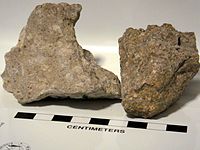
Photo from wikipedia
The recent (< 100 ka) volcanic stratigraphy of Terceira, Azores, includes at least seven peralkaline trachytic ignimbrite formations, attesting to a history of explosive eruptions. In this study, the petrogenesis… Click to show full abstract
The recent (< 100 ka) volcanic stratigraphy of Terceira, Azores, includes at least seven peralkaline trachytic ignimbrite formations, attesting to a history of explosive eruptions. In this study, the petrogenesis and pre-eruptive storage conditions of the ignimbrite-forming magmas are investigated via whole-rock major and trace element geochemistry, melt inclusion and groundmass glass major element and volatile compositions, mineral chemistry, thermobarometric models, and petrogenetic modelling. Our primary aims are to develop a model for the magmatic plumbing system from which the ignimbrite-forming trachytes of Terceira were produced by evaluating various petrogenetic processes and constraining pre-eruptive magma storage conditions. We also place the ignimbriteforming magmas into the context of the Terceira suite and discuss the potential implications of preeruptive magma conditions for eruptive behaviour. Results indicate that ignimbrite-forming, comenditic trachytes are generated predominantly by extended fractional crystallization of basaltic parental magmas at redox conditions around 1 log unit below the fayalite–magnetite–quartz buffer. This is achieved via a polybaric fractionation pathway, in which mantle-derived basalts stall and fractionate to hawaiitic compositions at lower crustal depths ( 15 km), before ascending to a shallow crustal magma storage zone ( 2–4 km) and fractionating towards comenditic trachytic compositions. The most evolved pantelleritic magmas of Terceira (not represented by the ignimbrites) are plausibly generated by continued fractionation from the comenditic trachytes. Syenite autoliths represent portions of peralkaline trachytic melt that crystallized in situ at the margins of a silicic reservoir. Trachytic enclaves hosted within syenitic autoliths provide direct evidence for a two-stage mingling process, in which ascending hawaiites are mixed with trachytic magmas in the shallow crustal magma storage zone. The resulting hybridized trachytes then ascend further and mix with the more evolved peralkaline trachytes in the uppermost eruptible cap of the system, passing first through a syenitic crystal mush. The reduced viscosities of the peralkaline silicic magmas of this study in comparison with their metaluminous counterparts facilitate rapid crystal–melt segregation via crystal settling, generating compositionally zoned magma bodies and, in some instances, relatively crystalpoor erupted magmas. Reduced viscosity may also inhibit highly explosive activity (e.g. formation of a sustained eruption column), and limit the majority of explosive eruptions to low pyroclastic fountaining or ‘boil-over’ eruption styles. The formation of intermediate composition magmas within the system is considered to be limited to episodic mixing between mafic and silicic magmas.
Journal Title: Journal of Petrology
Year Published: 2017
Link to full text (if available)
Share on Social Media: Sign Up to like & get
recommendations!